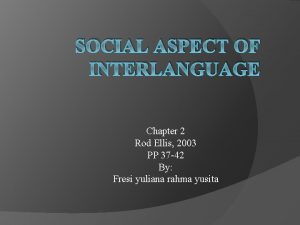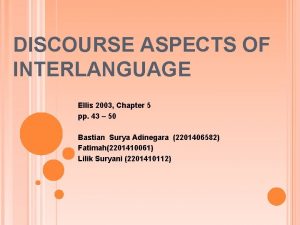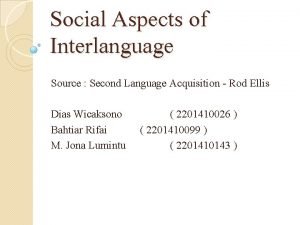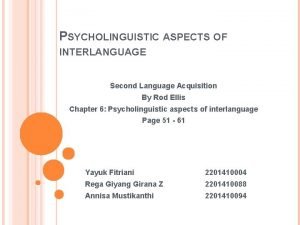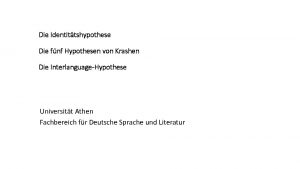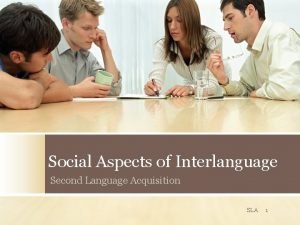Chapter 5 Social aspects of interlanguage Q Careful















- Slides: 15

Chapter 5 Social aspects of interlanguage

Q: Careful style vs. vernacular style (p. 38)

Q: Accommodation theory Have you experienced social cohesiveness or social distinctiveness? (p. 39)

The Acculturation Model (Schumann 1978, 1986) Ø The process of becoming adapted to a new culture Ø Second language acquisition is just one aspect of acculturation and the degree to which a learner acculturates to the TL group will control the degree to which he acquires the second language

Pidgin language may arise when two speakers of different languages with no common language try to have a makeshift conversation. Lexicon usually comes from one language, structure often from the other. Because of colonialism, slavery etc. the prestige of Pidgin languages is very low. Many pidgins are `contact vernaculars', may only exist for one speech event.

Creole is a language that was originally a pidgin but has become nativized, i. e. a community of speakers claims it as their first language. (people of Caribbean and African descent in colonial and ex-colonial countries -Jamaica, Haiti, Mauritius, Hawaii etc. )

pidgins ü learned as a second language ü a highly simplified linguistic structure ü as a means of establishing communication between two or more language groups creole languages ü more complex (a fully developed vocabulary and system of grammar) ü used for day-to-day purposes in a community ü acquired by children as a native language

Ø Social distance – individual learners become members of the TL group, and achieve contact with them Ø Psychological distance- individual learners are comfortable with the constitutes, rather personal

Q: Discuss your SLA in terms of social distance and psychological distance (p. 40)



Q: What is happening? (see the dialogue, p. 41)

Gardner’s (1983) socio-educational model of bilingual proficiency

Language socialization theory (Kramsch 2002; Bayley&Schechter 2003) Ø In the process of learning to become a member of a community, learners learn the L 2, and conversely, that part of learning an L 2 is becoming a member of the community that speaks it. Ø Language learning will be facilitated if socialization takes place and impeded if it does not.

Attitudes and L 2 learning Attitudes towards native culture Target culture Additive bilingualism + + Subtractive bilingualism - + Semilingualism - - Monolingualism + -
 Undelies
Undelies Interlanguage and social identity and investment
Interlanguage and social identity and investment Ellis 2003
Ellis 2003 Undelies
Undelies Psycholinguistic aspects of interlanguage
Psycholinguistic aspects of interlanguage Psycholinguistic aspects of interlanguage
Psycholinguistic aspects of interlanguage Rod ellis 2003
Rod ellis 2003 Psycholinguistic aspects of interlanguage
Psycholinguistic aspects of interlanguage Teoryang interlanguage
Teoryang interlanguage What is interlanguage?
What is interlanguage? Interlanguage theory
Interlanguage theory Interlanguage hypothese
Interlanguage hypothese Contrastive analysis error analysis and interlanguage
Contrastive analysis error analysis and interlanguage Interlanguage continuum
Interlanguage continuum Interlanguage and acculturation
Interlanguage and acculturation Interlanguage hypothese kritik
Interlanguage hypothese kritik

